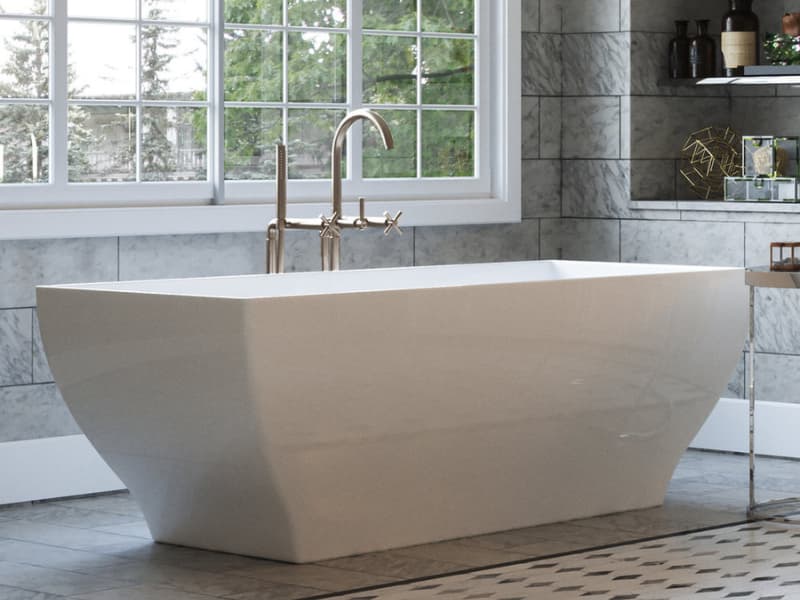You may have noticed that freestanding baths are becoming more common. These bathtubs, formerly considered a luxury only afforded to the wealthy and famous, are now more widely available than ever, with models to suit all preferences and price ranges.
However, there are several things to consider when choosing which standalone bathtub to purchase if you consider embracing this new bathroom trend. These include the design, type, material, shape, and model of the bathtub, and the amount of space available.
As a general rule, go for a tub that you’re comfortable living with. Some designs and materials are attractive but can be a problem for the long term. You don’t want your bath water turning green due to a copper tub.

What are freestanding tubs?
A freestanding tub stands by itself and is not attached to any walls, as the name suggests. Unlike the more popular alcove tub, which is finished only on one side, the tub has finished edges on all sides.
A freestanding tub can be positioned in the bathroom’s open space or near the walls. The location may benefit from a beautiful amenity, like a lovely view from a window or a fireplace.
Access to plumbing affects location. For example, a freestanding tub’s plumbing typically rises through the floor. You should also consider the placement of other fixtures in the bathroom such as sinks.
Freestanding tubs buying guide
Exploring the many freestanding bathtub types, sizes, and materials cannot be very clear. However, knowing your demands and the possibilities available will make your tub search more accessible and ensure that you choose the ideal style for your new spa-like retreat.
1. Bathtub design
Freestanding bathtubs are now available in many designs over the years. But first, select a plan that best compliments your bathroom’s decor and atmosphere.
A freestanding bathtub improves the appearance of any bathroom, even one with limited space.
Single backrest
This bathtub type has a single side with a raised backrest.
Elevated single backrest
Similar to the single backrest, this design features a raised backrest construction for added comfort.
Double backrest
Both ends of the bathtub side wall can be utilized as a backrest thanks to the faucet and drain located in the middle.
Elevated double backrest
Both ends may be utilized as a backrest, as in the double backrest design. But in this design, the ends are raised, giving you more room and optimal comfort.
Pedestal
This pedestal-style bathtub has a contemporary and chic appearance.
With feet
The bathtub’s feet have a classic and opulent appearance.
Corner or wall-adjacent
Some freestanding bathtubs can be placed against a wall or in a room corner.
2. Available bathroom space
The quantity of space in your bathroom is the first factor to consider before installing a standalone bathtub. Are you remodeling the current area? Or do you intend to swap out your outdated bathtub?
Freestanding bathtubs aren’t always as oversized as they used to be; different sizes are now offered. For instance, a smaller type, up to 60″ wide, will fit well in the area left by an old podium or alcove bathtub if you have a tiny amount of available room.
Make sure the interior of your freestanding bathtub is big enough for your needs; consider your height, weight, and the use the bathtub will receive.
3. Type of freestanding tub
For your freestanding bath, you can choose between two different models: a one-piece model or a two-piece model. Models manufactured in one piece are precisely what their name implies.
The bathtub comprises a skirt and a tub fitted within one another in two-piece variants. The skirts can come in various styles and are the most opulent of the two parts.
Two-piece bathtubs are more often available and are typically able to support faucets that are located on the bathtub’s edge.
Additionally, a two-piece model would be better if you wanted to put a massaging system in your bathtub because very few one-piece models can do so.
4. Manufacturing materials
Your bathtub’s design, practicality, and installation convenience are all influenced by the materials used in its manufacture.
Acrylic
A modern-looking, light material that is scratch-resistant and easy to maintain and repair.
AcrylX TM
A unique applied acrylic finish that shines brighter than fiberglass and keeps its factory-new appearance due to its UV resistance. Exclusive to the American Bath Group is this finish.
Fiberglass
This resin reinforced with fiberglass is flexible, light, and simple to maintain and mend.
Solid surface
A high-quality material (typically in a matte or glossy finish) combines resin and pure acrylic. It has the appearance and durability of stone without the weight. You thus won’t need to install shower tiles again if you went for lighter materials for your tub.
Cast iron
This is a thick, strong, and long-lasting material that is simple to clean and tough to scratch. However, this material is challenging to fix once it has been damaged. A cast iron bathtub offers a sophisticated, historic appearance.
These stylish, low-maintenance materials are old and modern: copper and stainless steel. In addition, water can stay at the same temperature for extended periods thanks to its heat-conducting qualities.
While these attributes apply to most metal tubs, their care routines differ given the individual quality sof the metals. For example, care for copper sinks and tubs is different from cast iron.
Stone
For a big bathtub, consider the load-carrying capacity of your floor. Stone offers a bold, contemporary, and natural appearance that will last.
5. Shape of model
Do you prefer a rectangle or oval bathtub? To establish a harmonious ambiance, your bathtub’s shape must complement the bathroom’s design. The design will give you a fair indication of what each design offers regarding bathtub shapes.
Bathtub shapes might be transitional, conventional, or contemporary.
6. The faucet
The sort of bathtub faucet you want to install is the only thing left for you to think about. This crucial detail shouldn’t be ignored, whether on the bathtub’s edge, self-supporting (on the ground) or set into the wall.
Your bathing experience can be significantly impacted by the type of faucet you select, which can also drastically alter the appearance of your bathtub.
Self-supporting
This option is the most expensive and requires the most floor space in your bathroom, but it also has the most attractive appearance. You can also insert a surface for storage space that will go well with the design of your bathroom.
Wall-mounted
This is a great option when there isn’t much room, but the bathtub needs to be close to the wall so the water stream will fall into the tub.
However, if the plumbing for a nook or corner bathtub has already been set up in this place, this alternative is efficient.
Faucet on the edge of the bathtub
This style of faucet, the least expensive choice, is simple to install and makes plumbing accessible afterward. Nevertheless, installing this kind of faucet on one-piece models might not be possible.
Conclusion
Choosing a freestanding tub for your home isn’t difficult if you have this checklist. It may be wise to talk to your plumber beforehand, as their recommendations will go a long way in determining the final decision you make regarding these tubs.
